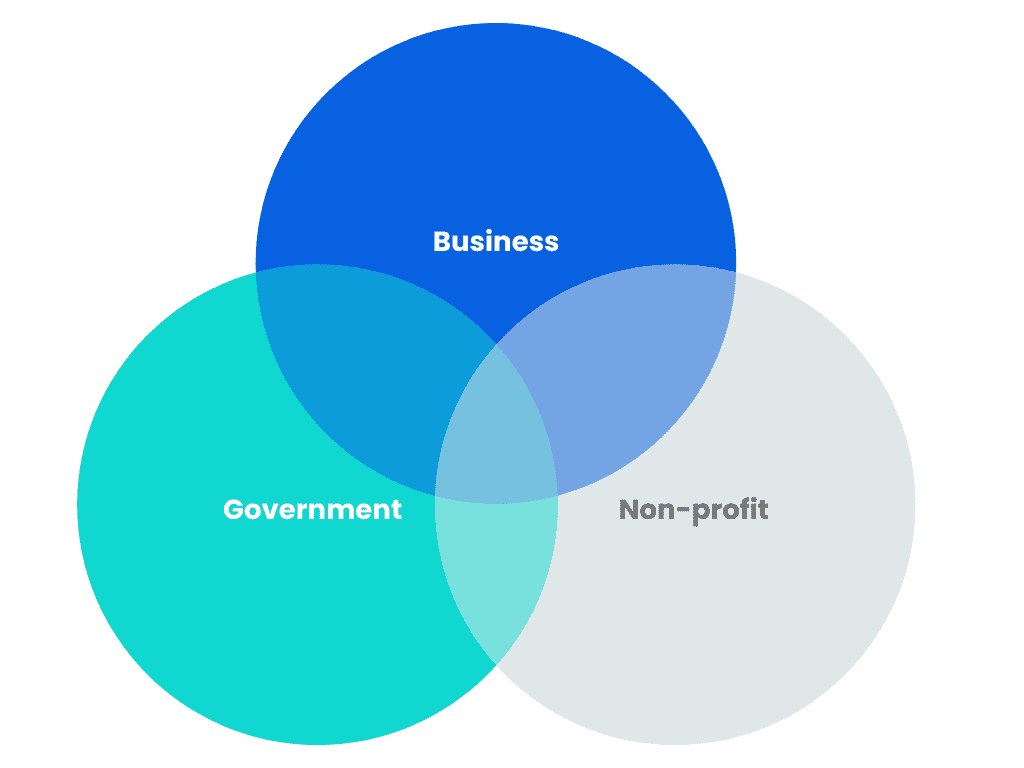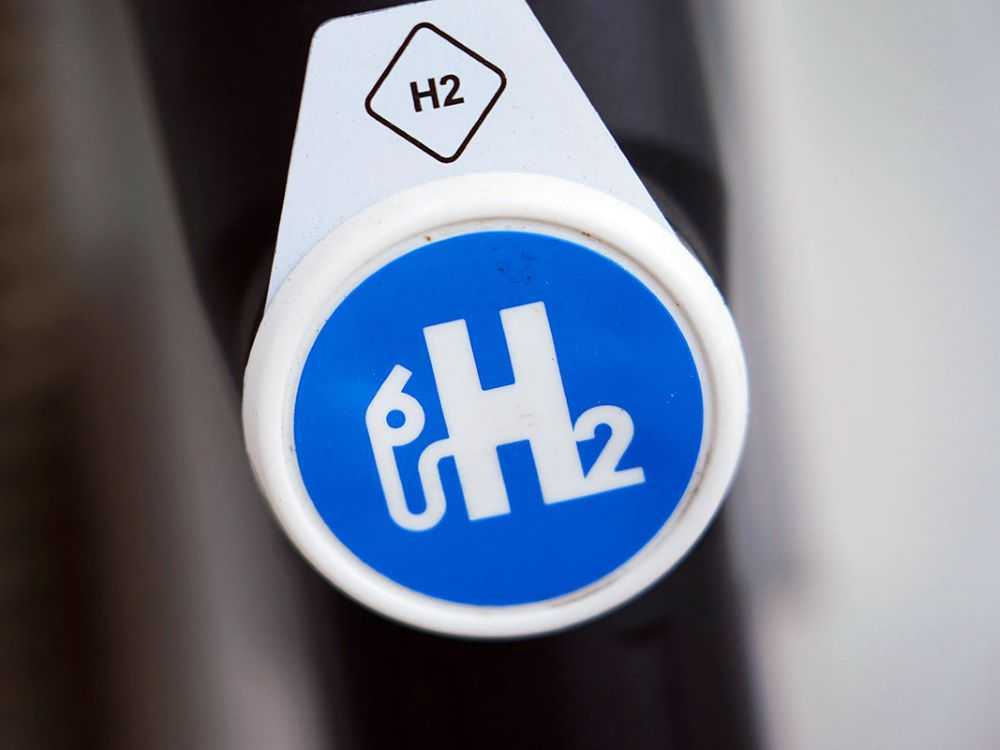The value of cross-sector partnerships
- Publication date
- Author
- Imogen Beech
- Reading time
- 8 minute read
Strategic partnerships are about organisations working together to reach common goals. And cross-sector partnerships are no different. The only thing added into the mix is that the organisations are – you guessed it – from different sectors!
Of course, that means there are some special considerations to take into account when you’re thinking about cross-sector collaboration. Here, we’ll answer all your questions about it, from how these partnerships work, to their unique benefits. Plus, we’ll look at some great cross-sector partnership examples that you can use for inspiration.
A cross-sector partnership is a partnership between two or more societal sectors (business, the government and nonprofit).
In other words, if the government partners with a business, that’s a cross-sector partnership. The same goes if a business partners with a nonprofit. Or a nonprofit partners with the government.
Normally, these kinds of partnerships are used to help solve big, important issues – issues that are too big for one organisation or sector to tackle alone.
Let’s think, for example, about a huge problem like climate change. There are lots of different organisations that are trying to help solve this issue. There are shops selling sustainable products, engineers working to build hydrogen fuel cells, car manufacturers developing electric cars, governments putting new rules and commitments in place, charities fighting to protect the rainforests… the list goes on.
Each of these entities is doing its bit to combat climate change in its own niche area. But none of them can make a big impact on the overall issue without the help of the others – the problem is simply too big to handle alone.
That’s where cross-sector partnerships come in. Entities from different sectors, who have different strengths and specialisms, can formally agree to leverage their resources, funding and expertise to work towards shared goals.
Another way of looking at it is like this. When there’s a complex societal problem, you have two options: break the problem down into smaller, simpler problems and pick one to tackle; or tackle the larger problem in all its complexity.
The first option is easier, but you can only make so much impact. The second option, on the other hand, may be more complex, but there’s more potential to make a real difference. And a cross-sector partnership can help you get there.

As we’ve touched on already, collaborating with cross-sector partners is a great way of being able to solve large issues that you simply wouldn’t be able to impactfully address alone. But why is that? Here’s the nitty-gritty of exactly why cross-sector partnerships are so great.
Ultimately, these benefits all point to one thing: effectiveness. By collaborating successfully with a cross-sector partner, organisations can expect their activities to be more effective, as they’ll be leveraging two skill sets, two sets of resources, two reputations and so on. You know the saying ‘two heads are better than one!'
Cross-sector partnerships have the potential to be fantastic for your organisation. But they’re not all roses and sunshine!
Any partnership comes with its own obstacles. In fact, if we collate stats from ‘The Art of Strategic Partnering,’ Harvard Business Review and LGC, we can confidently say that around 60% to 70% of strategic partnerships fail. Of course, what constitutes failure is debatable (for instance, McKinsey found that 25% of joint venture partnerships don’t meet or exceed either partner’s expectations but still benefit all the companies involved) – but all the same, it’s a staggering figure.
When it comes to cross-sector collaborations, developing a successful partnership comes with all the same challenges – but you’re also dealing with partners who come from vastly different worlds and who have contrasting motivations. Here are a few of the obstacles you can expect to have to overcome.
As we’ve mentioned already, cross-sector partnerships are about organisations working together to achieve shared goals. But even though partners may have goals in common, that doesn’t mean their motivations for achieving those goals are the same. One common niggle that crops up time and time again with cross-sector partnerships is organisations refusing to accept one another’s motivations.
For instance, a government agency or NGO might struggle to accept that their commercial partner wants to make a profit from a social or environmental issue. In order for the partnership to flourish, they’ll need to accept that making a profit is a legitimate motive.
Similarly, a business might struggle to accept that its partnership with a government agency is going to be used to push forward a regulatory goal that they disagree with. Again, the partnership can’t fulfil its potential unless the business agrees to make peace with this fact.
Of course, alignment on motivations has the potential to be a sticking point in any type of strategic partnership. It’s just that with cross-sector partnerships, different missions and belief systems are a given – broadly speaking, businesses exist to make money, nonprofits to help people, and governments to organise a community. In order for a cross-sector partnership to work, partners have to not just accept, but also embrace these differences – they’re what give these types of partnerships so much potential.
Interestingly enough, our next common sticking point for cross-sector partnerships has nothing to do with the relationship between partners per se. Instead, it’s to do with issues within the individual partner organisations.
All too often, a partnership agreement is reached between the leaders of two organisations and then simply announced to the teams who are expected to integrate and execute it, without ever properly socialising the new partnership internally. It seems obvious that the people handling the day-to-day operations of a partnership should have a say in how to negotiate and manage it, but this often isn’t the case.
To make sure your partnership runs smoothly, it’s important to engage your whole team both during the negotiation phase and in the immediate aftermath. Crucially, you’ll need to explain to your team why you’ve decided to embark on this partnership, what the goals are and what your organisation stands to gain.
By ensuring your whole team is fully onboard and singing from the same hymn sheet, you’ll be able to avoid confusion, enable individuals within your organisation to take on a greater level of responsibility and accountability, and ultimately execute your partnership much more seamlessly.
Finally, cross-sector partnerships suffer all too often from an imbalance of power between the partners involved. It’s a problem that can crop up in all kinds of partnerships, but cross-sector collaborations are especially susceptible, where you might get a big multinational organisation working with a small NGO. Or an independent business being contracted by the government, with the government calling many of the shots.
Partners have to make decisions in a way that’s inclusive and collaborative. If they don’t, friction will undoubtedly arise. Not only that, but you risk one party benefiting more than the other, which in turn leads to one being more invested than the other.
If one partner stands to gain more from a partnership, they can’t expect their partner organisation to put in as much time, effort and resources. And without both parties being fully invested, neither will unlock the full potential of the partnership or gain as much as they might have hoped to.
Make sure that you put plans in place at the outset of a partnership about how you’re going to make decisions as a pair. The more you can agree at the negotiation phase of a partnership, the less room there’ll be for disagreements down the road.
There’s no one common form that you can expect a cross-sector partnership to take. Rather, a cross-sector partnership could look like any other type of strategic partnership – it might be a distribution marketing partnership, a product partnership or a form of outsourcing, for example. The only real difference is that the partners are from different sectors.
Likewise, a partnership between a business or a charity is both a cross-sector partnership and a charity partnership.
With that in mind, here are three examples of cross-sector partnerships that show off the broad range of partnerships you can expect to encounter.
Homes England is a non-departmental public body that’s responsible for increasing the number of new homes that are built in England – including affordable housing. To reach their goals, they’re constantly teaming up with new partners that share their ambition to build better homes faster.
In September 2021, they created a whopping 31 new strategic partnerships aimed at delivering 90,000 affordable homes funded through grants. Notably, four of these partnerships were with for-profit associations, including Legal & General and McCarthy Stone. This was the first time that Homes England made its funding available to for-profits – a move that it’s hoped will enable them to deliver on their goals quicker.
Altogether, the 31 new strategic partners are set to access nearly £5.2 billion through the Affordable Homes Programme (AHP). You can read more about in our partnership news roundup from September 2021.

In 2020, coffee shop Starbucks teamed up with Mermaids – a charity that supports gender-diverse children, young people and their families. Their excellent charity partnership example was dreamed up when Starbucks discovered members of the transgender community were using their stores to trial their chosen names.
The collaboration was multifaceted. To kick things off, the pair launched a TV ad that aimed to boost awareness of gender diversity. At the same time, Starbucks pledged to contribute at least £100,000 to help Mermaids expand its helpline services, selling limited-edition mermaid-shared cookies in participating stores to raise money for the charity. And finally, Mermaids worked closely with Starbucks to develop the coffee shop’s own transgender inclusion policies.
By using Starbucks’ reach and resources and Mermaids’ expertise, the pair were able to raise awareness of gender diversity, show Starbucks in a positive light and raise money for an important cause.
In July, Warwick District Council put out a callout for a new commercial partner that could help them to develop a hydrogen fuel production facility – in fact, we wrote about it in our July partnership news roundup!
This is the perfect example of a cross-sector partnership in the making – while the council has land and £50,000 to contribute to the project, they’re lacking the experience and expertise to implement it alone. By teaming up with a commercial partner, they can gain important know-how, enabling them to achieve their goals of bringing benefits such as decarbonisation to the district.
At the same time, the council recognises that the project has the potential to bring commercial benefits to the region, which could appeal to a commercial partner. Seems like the perfect environment for a cross-sector partnership to flourish!

We often feature cross-sector partnerships in our monthly strategic partnership news roundups – just look at the example of Boston Consulting Group (BGC) becoming the exclusive strategic partner for COP27 to see how prevalent these kinds of partnerships really are!
–
As you can see, cross-sector partnerships can come in many different forms and can bring brands, nonprofits and the government a whole host of benefits – from shared skills and expertise to increased reach and pooled resources.
Interested in forming a cross-sector partnership of your own? Read our guide to creating successful strategic partnerships for some top tips. Or, if you’re ready to locate your ideal partners, whatever sector they may be in, make sure to book a demo for Breezy.
Our unique partner intelligence and discovery platform will be able to uncover thousands of relevant leads that could make all the difference to your brand. Enjoy!
Imogen is a copywriter and content writer with over two years’ experience writing about the exciting world of strategic partnerships, as well as running her own business. She loves learning about new topics as she writes, and has enjoyed penning articles on industries ranging from mortgages to events, theatre to home improvements and everything in between.
View more by Imogen Beech